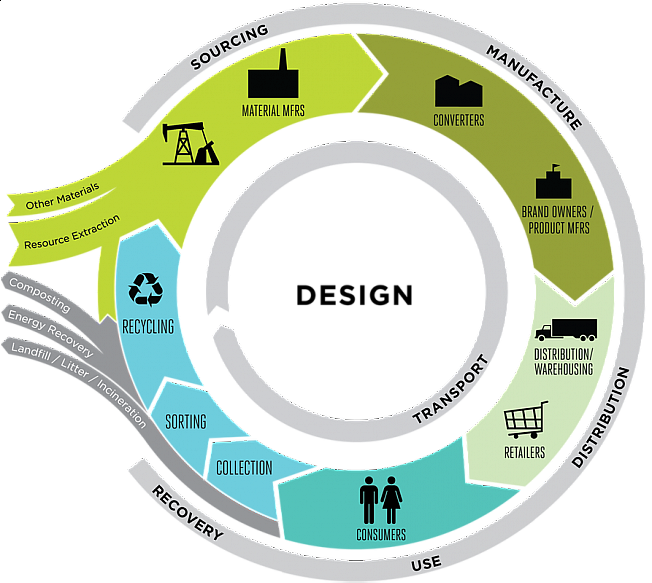March 10, 2015
The catchphrase for the recycling industry these days is “Sustainable Materials Management.” It offers an opportunity for professional recyclers to move beyond our historically and limitedly defined role of “recycling professional.”
NERC’s Spring 2015 Conference, Own the Future - Creative Options to Sustainable Materials Management, being held in partnership with the Delaware Solid Waste Authority, will bring together sustainable materials management professionals to explore product stewardship, extended producer responsibility, single-stream recycling and other issues on the horizon.
According to the US Environmental Protection Agency, Sustainable Materials Management (SMM) is “an approach to serving human needs by using/reusing resources most productively and sustainably throughout their life cycles, from the point of resource extraction through material disposal. This approach seeks to minimize the amount of materials involved and all the associated environmental impacts, as well as account for economic efficiency and social considerations.”
The Organization for Economic Co-operation and Development (OECD) defines SMM as “an approach to promote sustainable materials use, integrating actions targeted at reducing negative environmental impacts and preserving natural capital throughout the life-cycle of materials, taking into account economic efficiency and social equity.”
GreenBlue’s definition of SMM is multi-faceted:
- Use Wisely - The old adage “waste not, want not” is more relevant now than ever. Use Wisely means that at each step of the production life cycle, we must seek to conserve material resources. The concept of dematerialization means combining various conservation strategies such as reducing the amount of materials needed to provide the function required, extending the service life of products, and eliminating the concept of waste by ensuring that there are robust markets to reutilize post-industrial and post-consumer materials.
- Eliminate Toxicity - Providing consumers with products and services that are safe for people and the environment is only possible if they are made out of safe materials. GreenBlue is developing information sharing tools to help manufacturers communicate with each other along the entire product value chain, enabling them to make more informed decisions about the chemicals and materials they use to manufacture products.
- Recover More - Recovering more value out of the materials economy is synergistically related to the principle of using materials wisely, because outputs from one part of an industrial system should be used as inputs to some other part of the system, so design issues impacting sourcing and end of life considerations start to become aligned.
- Life Cycle Design - Sustainable materials management is predicated on life cycle design which is a process for identifying the positive and negative impacts of the life cycle of materials as they are produced and consumed in an economy.”
NERC staff asked members of its conference organizing committee, along with conference presenters, to weigh in on the SMM definition, here are their responses:
- Chaz Miller, State Programs Director, National Waste & Recycling Association
“Sustainable Materials Management is making products with the least material and energy use impacts on the environment, throughout the life cycle of the product.”
- Rick Watson, Chief Executive Officer, Delaware Solid Waste Authority
Mr. Watson agrees with EPA’s SMM definition – “Sustainable Materials Management is the use and reuse of materials in the most productive and sustainable way across their entire life cycle. SMM conserves resources, reduces waste, slows climate change, and minimizes the environmental impacts of the materials we use.”
- Sherill Baldwin, Environmental Analyst, Department of Energy and Environmental Protection
Ms. Baldwin cites Oregon’s 2050 Vision and Framework for Action:
“The materials management approach seeks to reduce environmental impacts by managing materials throughout all stages of their life cycle. Materials management includes waste prevention and discards management. More broadly, it identifies impacts and actions to address those impacts across the full life cycle of materials and products as they move through the economy – starting with design and continuing through raw material extraction, manufacture, transport, consumption, use, reuse, recycling and disposal.”
- Jerry Powell, Executive Editor, Resource Recycling
“Sustainable materials management (SMM) is being seen as the new, improved way to assess how materials are produced and products are made and used. Given the experience in Oregon, where SMM has replaced the traditional waste hierarchy and where the state environmental agency has fully moved to an SMM approach, a number of unique and intriguing hurdles exist in an SMM system.”
- Bob Peoples, Ph.D., Executive Director, CARE
SMM is:
“A systems approach (LCA, social justice, rapidly renewable, green chemistry, etc.) which encompasses raw material selection, design for EOL management, reuse and recycle systems. It includes dematerialization and evolves as technology advances (a process). SMM engages all stakeholders.”
- Scott Cassel, Chief Executive Officer/Founder, Product Stewardship Institute, Inc.
Mr. Cassel also agrees with EPA…“Sustainable materials management is the use and reuse of materials in the most productive and sustainable way across their entire life cycle. Sustainable materials management conserves resources, reduces waste, slows climate change, and minimizes the environmental impacts of the materials we use.” But he would also add to the definition: “Economic development, since if we are using materials better, we are recycling and that creates jobs.”
- Susan Robinson, Public Affairs Director, Waste Management
Ms. Robinson defines SMM as: “Making materials management decisions based on Life Cycle Thinking. Sustainable Material Management decisions should factor in the net economic, social, and environmental impacts of these decisions.”




Comments (0)
Add a Comment